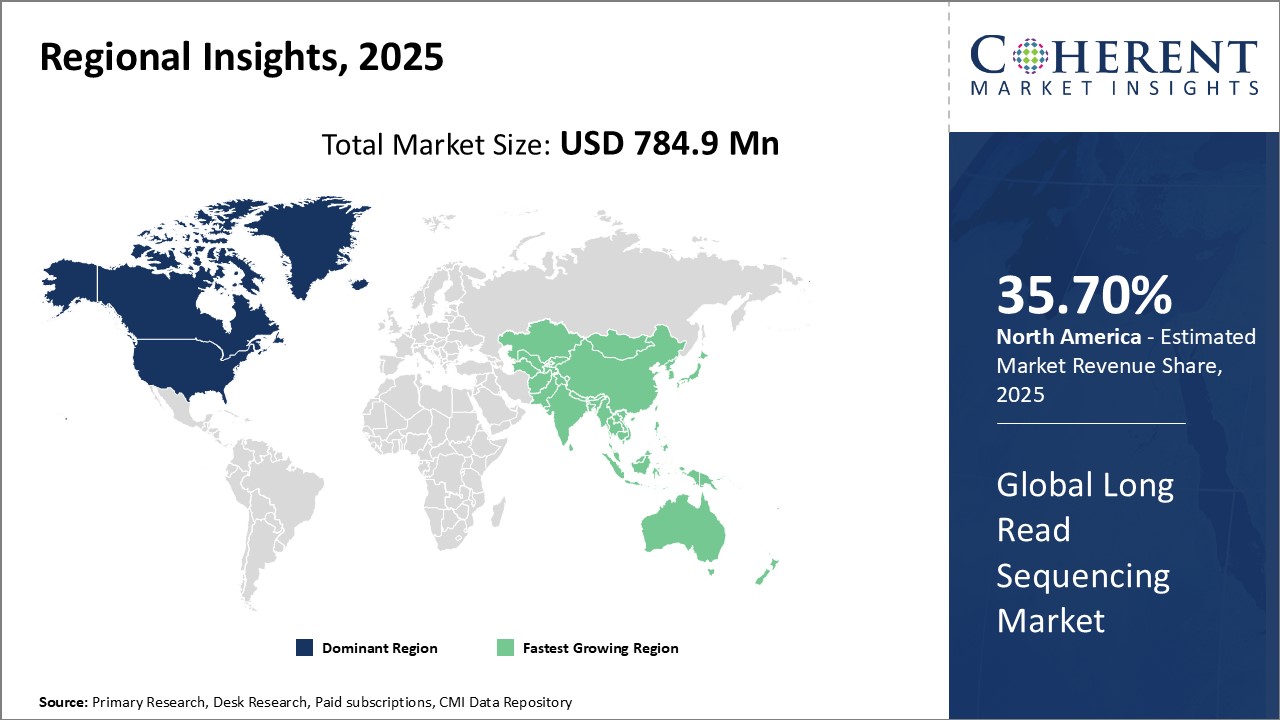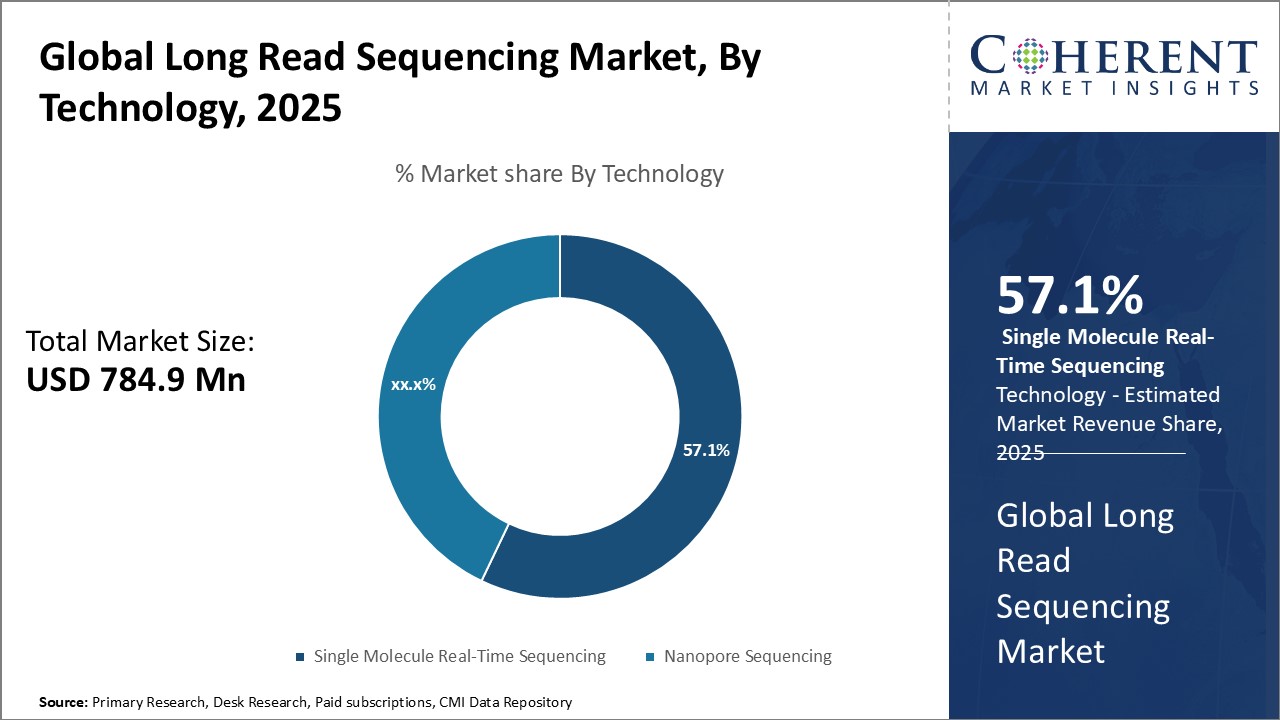Global long read sequencing market size is expected to reach US$ 5,224.1 Mn by 2032, from US$ 784.9 Mn in 2025, exhibiting a compound annual growth rate (CAGR) of 31.1% during the forecast period.
Long read sequencing which is also known as third-generation sequencing, allows sequencing of longer deoxyribonucleic acid (DNA) fragments compared to traditional short read sequencing technologies. There are two main products in the long read sequencing market - PacBio Sequencing Systems and Oxford Nanopore Sequencing Systems.
Global Long Read Sequencing Market- Regional Insights
- North America is expected to be the largest market for long read sequencing during the forecast period, accounting for over 35.7% of the market share in 2025. North America has established itself as the dominant regional market for long read sequencing. The region is home to several leading life sciences companies that are pioneering innovation in sequencing technology. Strong government funding for biomedical research has encouraged rapid technological advancement.
- Asia Pacific is expected to be the second-largest market for long read sequencing market, accounting for over 25.2% of the market share in 2025. Asia Pacific meanwhile is the fastest growing regional market for long read sequencing. Several factors contribute to the region's burgeoning growth rate. Countries like China and India are making vast public investments to build out their capabilities as part of ambitious national bioscience development agendas.
- The long read sequencing market in Europe is experiencing robust growth, driven by advancements in research, increasing demand for personalized medicine, and a rising focus on precision healthcare. The key factors contributing to the market expansion include growing investments in life sciences research, expanding applications of long read sequencing.
Figure 1. Global Long Read Sequencing Market Share (%), By Region, 2025

To learn more about this report, Download Free Sample
Analyst’s Views: Global long read sequencing market is experiencing steady growth driven by factors such as increasing research and development (R&D) by the market players. Moreover, increasing focus towards personalized medicine is expected to aid in the market growth over the forecast period. Increasing funding for the research is expected to garner market traction over the forecast period.
Global Long Read Sequencing Market- Drivers
- Increasing applications in DNA sequencing: Increasing applications of DNA sequencing in various fields such as precision medicine, genomics research, and diagnostics of genetic diseases is one of the major factors fueling the growth of global long read sequencing market. Long read sequencing allows analysis of entire genomes and full-length transcripts, which provides valuable insights for research in complex genomes, transcriptomes, epigenomes, and metagenomes.
- Increasing funding and investments: Global long read sequencing market is experiencing significant growth due to rising investments and funding in this domain over the recent years. Long read sequencing allows scientists to view complete gene sequences or read extremely long strings of deoxyribonucleic acid (DNA)/ ribonucleic acid (RNA) bases. This vast genomic information provided by long read sequencing is revolutionizing the fields of genomics, clinical diagnosis and disease research. For instance, in 2020, Ms. Maizie (Xin) Zhou, assistant professor of biomedical engineering and computer science, is the recipient of a US$1.9 million award from the National Institutes of Health. She has also received US$120,000 from Complete Genomics, a leader in human genome sequencing.
Global Long Read Sequencing Market- Opportunities
- Potential applications in clinical diagnosis and precision medicine: Long read sequencing has exciting applications in clinical diagnosis that could drive significant growth in this market. One of the greatest challenges in diagnosis has been identifying structural variants like insertions, deletions, and rearrangements that are difficult to detect with short read technologies. Long reads allow researchers to assemble complete genomes and detect these variants with high accuracy. This will enable more precise diagnosis of genetic diseases and disorders. For example, long reads have helped identify the genetic causes of certain types of epilepsy and dementia that were previously unknown. With improvement in genetics, long read sequencing will be pivotal in analyzing the full spectrum of variants contributing to many conditions. This new diagnostic capability could revolutionize personalized treatment approaches.
Global Long Read Sequencing Market Report Coverage
| Report Coverage | Details | ||
|---|---|---|---|
| Base Year: | 2024 | Market Size in 2025: | USD 784.9 Mn |
| Historical Data for: | 2020 To 2024 | Forecast Period: | 2025 To 2032 |
| Forecast Period 2025 to 2032 CAGR: | 31.1% | 2032 Value Projection: | USD 5,224.1 Mn |
| Geographies covered: |
|
||
| Segments covered: |
|
||
| Companies covered: |
Illumina Inc., Pacific Biosciences, Oxford Nanopore Technologies, PerkinElmer, Stratos Genomics, Phase Genomics, 10x Genomics, Genapys, Bionano Genomics, and Other Prominent Players |
||
| Growth Drivers: |
|
||
| Restraints & Challenges: |
|
||
Uncover macros and micros vetted on 75+ parameters: Get instant access to report
Global Long Read Sequencing Market- Trends
- Increasing custom research applications: Growing demand for custom research applications of long read sequencing technology from both academia and industry is significantly driving the global long read sequencing market. Researchers and scientists across various domains such as genetics, microbiology, and molecular biology are leveraging the customization potential of long read sequencing to gain novel insights specific to their work. For example, in 2021, scientists at the Mayo Clinic used Pacific Biosciences long read sequencing in a customized manner to sequence the genome of an infant with rare genetic disorder, which helped identify the exact genetic mutations responsible. This aided in providing the family with information on future risk and clinical management.
Global Long Read Sequencing Market - Restraints
- Complex data analysis of long reads: The high complexity involved in the analysis of long read sequencing data has emerged as a major bottleneck restricting the widespread adoption and growth of this promising technology. Long read sequencing can generate reads that are 10-100x longer than short read technologies. However, aligning and assembling these long reads poses considerable computational and bioinformatics challenges. Unlike short reads which can be easily mapped to reference genomes, long reads due to their large size cannot be accurately aligned and analyzed by using conventional short read assembly tools. Developing customized algorithms and infrastructure capable of handling gigabytes to terabytes of complex sequencing data from a single long read run is still a work in progress. This has made it difficult for many smaller labs and institutions without access to high performance computing capability to fully utilize the potential of long read sequencing.
Counterbalance: To overcome this restraint, it is needed to develop customized algorithms and infrastructure which is capable of handling gigabytes to terabytes of complex sequencing data from a single long read run.
Figure 2. Global Long Read Sequencing Market Share (%), By Technology, 2025

To learn more about this report, Download Free Sample
Global Long Read Sequencing Market- Recent Developments
Key Developments
- On March 14, 2023, Illumina Inc., a DNA sequencing and array-based technologies company, announced its product that is based on complete long read technology which available to order
- On October 25, 2022, PacBio, a developer of high-quality, highly accurate sequencing solutions, announced the Revio long-read sequencing system, which will enable customers to dramatically scale their use of PacBio’s celebrated HiFi sequencing technology
Business Development Activities by the Market Players
- On August 7, 2023, PacBio, a developer of high-quality, highly accurate sequencing solutions and GeneDx, a company delivering improved health outcomes through genomic and clinical insights, announced a research collaboration with the University of Washington to study the capabilities of HiFi long-read whole genome sequencing (WGS) to increase diagnostic rates in pediatric patients with genetic conditions.
Top Companies in the Global Long Read Sequencing Market
- Illumina Inc.
- Pacific Biosciences
- Oxford Nanopore Technologies
- PerkinElmer
- Stratos Genomics
- Phase Genomics
- 10x Genomics
- Genapys
- Bionano Genomics
- Other Prominent Players
Definition: The process of reading part or all of the DNA of an organism is helping to improve clinical care across different areas of medicine, from rare diseases and cancers, to the management of infectious diseases.
Share
Share
About Author
Abhijeet Kale is a results-driven management consultant with five years of specialized experience in the biotech and clinical diagnostics sectors. With a strong background in scientific research and business strategy, Abhijeet helps organizations identify potential revenue pockets, and in turn helping clients with market entry strategies. He assists clients in developing robust strategies for navigating FDA and EMA requirements.
Missing comfort of reading report in your local language? Find your preferred language :
Transform your Strategy with Exclusive Trending Reports :
Frequently Asked Questions
Select a License Type
EXISTING CLIENTELE
Joining thousands of companies around the world committed to making the Excellent Business Solutions.
View All Our Clients





